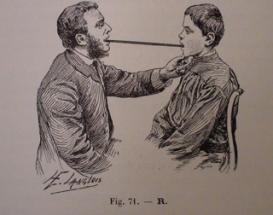The battle around the definition of deafness was a conflict between the human sciences not only about who knew and understood mankind the best, but also about who should be in charge of transforming mankind so as to bring it to its optimum condition.
Sabine Arnaud's research examined a French and Italian corpus on deafness between 1750 and 1914 with a view to considering how deafness was conceptualized as a problem. She investigated the struggles between medicine and education, and how such struggles shaped both the writing in these disciplines and their positioning toward each other.
One of her case studies was Victor, a “wild child” who had been found in the woods in France in the early nineteenth century and who could not speak. Victor's case very soon became famous, and it attracted the interest of men of letters who were eager to understand the role of language and education in the development of the human being. Victor was entrusted to the care of the National Institute for the Deaf-Mute; this was one of the first moments when the status of deafness was defined with reference to mental infirmity.
Around the 1880s, the understanding of deafness as an auditory imbalance was further transformed into that of an anomaly defining a population of abnormal people. By bringing the question of the deaf to the fore, this moment led to the emergence of a wide range of new fields: the remit of knowledge about deafness expanded from medical questions about hearing and speaking (now reframed as otology and laryngology) towards other medicalized specialties such as hygiene, psychology, and psychiatry. This process increasingly framed the understanding of deafness as part of an enquiry on normal and abnormal human development also notably involving the disciplines of anthropometry and criminology. Her time frame ended with the radical shift that took place at the turn of the century, when a series of laws made education obligatory for all children in several countries. This shift prompted the emergence of a new discipline called “educational hygiene,” which addressed those considered unable to follow education in its regular form and those assigned to categories such as the mentally retarded, the backward, deaf, or idiots—all of them defined as “abnormal.”
Claire Shaw was part of the research project for three months to work on her project “Revolutionising Deafness: Russian Visions of the Disabled Self across 1917.” A lecturer at the University of Bristol, she examined how the Russian revolutions of February and October 1917 represented a radical break from European scientific tradition, with Marxist ideologies of self and society producing new and revolutionary discourses of disability. Disability was now understood not as a "problem" to be solved by science, but as an obstacle that could be overcome—in accordance with the Soviet model of the ideal self (the "New Soviet Person")—through social reform and individual effort. Similarly, certain fundamental criteria of the "normal" as defined by European specialists, such as the use of spoken language, gave way to a new understanding of "work capability" ("trudosposobnost") as the foundational measure of human worth, a shift which liberated the deaf community from charity and tutelage and facilitated their integration into the Soviet collective.
During her time at the Institute, Shaw examined Russian and Soviet understandings of deafness from approximately 1890 to 1925. She considered materials primarily from the fields of psychology (looking, in particular, at the work of revolutionary child psychologist Lev Vygotskii) and education (focusing on publications by pre-revolutionary teachers of the deaf, and by the first Soviet Commissar of Enlightenment, Anatolii Lunacharskii). Moreover, by examining documents produced by deaf societies and social clubs in this period, the project considered how the nascent Russian deaf community responded to these shifts in ideological frameworks and sought to articulate a coherent vision of individual and collective selfhood among the deaf.
Over several short residencies, Claudia Stein investigated the role of history and ethnology and their material display in the construction and representation of biopower at the International Hygiene Exhibition in Dresden (IHA) (1911). Historians of science and medicine have regarded the IHA as a defining moment in the popularization of scientific medicine and its conceptualization of the modern "normal" body. For Claudia Stein, the IHA was the most prominent and visible example of the how biopower was thought to be exercised and implemented at the beginning of the twentieth century. What is less know about the IHA is that under the presiding hand of Germany’s most eminent historian of medicine at the time, Karl Sudhoff (1853–1938), a historical and ethnological section attempted to sell a history of the development of the normative body through a display of some 20,000 objects and artefacts spread over 2,400 square meters, in over 70 rooms, hallways, and galleries. There had been hygiene exhibitions before, dating from the 1870s, but never on this scale nor with dedicated attention to historico-ethnological display. During her stay, Claudia Stein considered the role attributed to these disciplines in the making and distribution of knowledge about the modern normative body and the regulation of populations.
During her Postdoctoral Fellowship at the Institute, Anja Werner focused on the treatment of deaf education in nineteenth-century German and American journals. She traced how the public debates about oralism (speech), and German science’s commitment to providing the deaf with hearing devices, pushed deaf education in Germany towards the teaching of articulation, while German supporters of signed languages remained invisible in the internationally-circulating German press.

Project
(2013-2016)
Medicalization at the Intersection of the History of Psychology and the History of Education
- Sabine Arnaud Claire Shaw Claudia Stein
